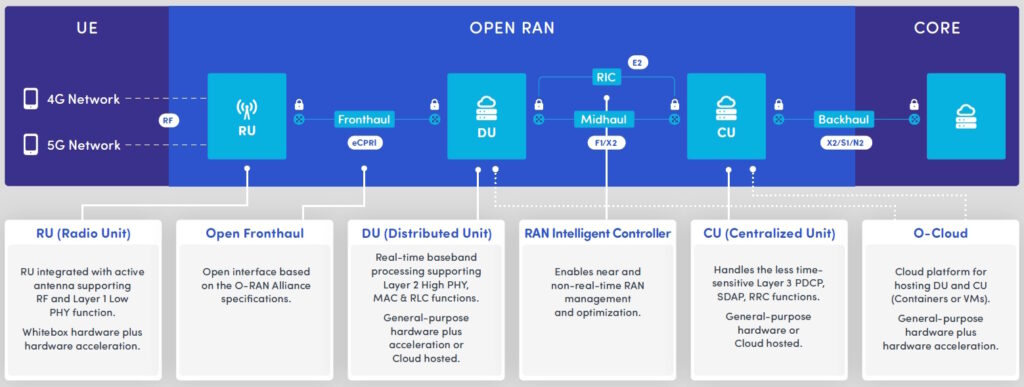
Integration and test issues with Open Radio Access Networks (O-RAN) arise from their multi-vendor architecture. O-RAN consists of separate elements, such as radios, baseband units, and software, that can be sourced from different vendors.
O-RAN was developed to promote greater flexibility, competition, and cost-efficiency compared to proprietary RAN alternatives. The elements are complex sub-systems that must work seamlessly together.
This article presents an overview of the O-RAN architecture, reviews some of the complexities of O-RAN testing and integration, and concludes by explaining why automation is required to ensure success.
The O-RAN sits between the user equipment (UE) and the network core (Figure 1). O-RAN elements must conform with 3GPP standards and O-RAN Alliance requirements. Key elements include:
- Radio units (RU) convert digital data and RF signals, including beamforming and antenna array.
- The distribution unit (DU), sometimes called the digital unit, performs real-time baseband processing and handles lower-level radio processing tasks like Medium Access Control (MAC) and Radio Link Control (RLC).
- RAN intelligent controller (RIC) is a software-based component that enables the disaggregation of RAN elements. It’s a differentiator of O-RAN and provides a central point for collecting real-time data from different parts of the RAN and making decisions about resource allocation, load balancing, interference mitigation, etc. In addition, the RIC can leverage artificial intelligence and machine learning algorithms to analyze network data and adjust in real time, improving network efficiency.
- A centralized unit (CU) manages the higher layers of the protocol stack, like radio resource control (RRC), service data adaptation protocol (SDAP), and packet data convergence protocol (PDCP).

Figure 1. Block diagram of an O-RAN. (Image: Spirent)
Testing considerations
The challenge with O-RAN testing is ensuring multi-vendor compatibility. O-RAN uses open interfaces, which add to testing complexity and troubleshooting due to the numerous possible configurations and interactions between elements from the same or different vendors. Identifying the root cause of problems can be daunting, especially in a multi-vendor O-RAN scenario.
Performance validation needs to test the combined operation of all the elements of the O-RAN under maximum traffic conditions to ensure the expected performance, including throughput, latency, call quality, and so on. For example, data transfers between RUs and DUs from different vendors must be consistent and glitch-free. Testing should also confirm the compatibility of management and configuration tools from different vendors.
Testing structure
O-RAN testing consists of nodal, adjacent, end-to-end, and security testing. Nodal testing ensures that specific O-RAN elements are validated. During nodal testing, the element like a DU or CU is integrated with emulated network functions and traffic to simulate actual operating conditions. Nodal testing is performed at peak capacity and performance levels to ensure reliable performance.
Adjacent testing involves integrating and testing elements with adjacent network functions, such as testing the RU with the DU and the DU and CU with the RIC. This can involve elements from the same vendor or various vendors. Adjacent testing is key to ensuring interoperability at scale and in a dynamic network environment.
End-to-end testing takes the process to its final stage. It tests the entire O-RAN at capacity and scale for all expected services, including voice, data, video, emergency services, etc.
Security is critical since an O-RAN includes elements from multiple vendors, which means it has more possible points of entry and numerous attack surfaces. Security testing should consist of individual elements and end-to-end testing that emulates different types of attacks.
Automation can tie it all together.
Automation is necessary to ensure O-RAN interoperability. It can support integration and management of equipment from multiple vendors and eliminate costly and time-consuming manual configuration and verification.
Without automation, O-RAN benefits like agility and efficiency can be lost. From this perspective, O-RAN testing consists of three primary scenarios: conformance, interoperability, and end-to-end testing, which are tied together with automation (Figure 2). Each element includes a set of testing plans to ensure that O-RAN products meet the required specifications as single units and in combination with other products when integrated into the network.

Figure 2. Automation ties together the three O-RAN testing scenarios. (Image: Ericsson)
Summary
The benefits of greater flexibility, competition, and cost-efficiency of O-RAN come at the cost of more challenging integration and testing issues. Individual elements like the DU and CU must be tested to ensure their performance and compatibility with other elements from different vendors. Vendor diversity also makes it more challenging to ensure O-RAN security.
References
Consistent and Repeatable Testing of O-RAN Distributed Units (O-DU) across Continents, Arxiv
How automated testing can help address the Open RAN deployment challenges, Ericsson
Meeting the Complex Challenge of O-RAN Testing, Spirent
Open RAN integration: Don’t go it alone, Fujitsu
Revolutionizing Radio Unit Testing, LitePoint
Solving Test and Integration Challenges for Open RAN, Keysight
Testing can make Open RAN a success, Rohde & Schwarz
EEWorld Online related content
5G Over-the-Air Testing: An update
5G radios increase emphasis on compliance testing
Open RAN rewrites network-testing rules
How do you test an Open RAN installation?
Why open RAN needs testing to ensure interoperability







